The Scandinavian Influence on OldEnglish ( 450 -1150)
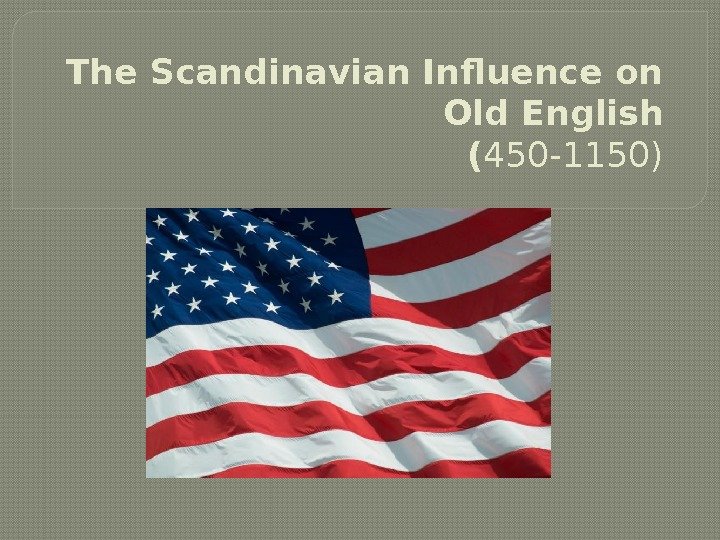


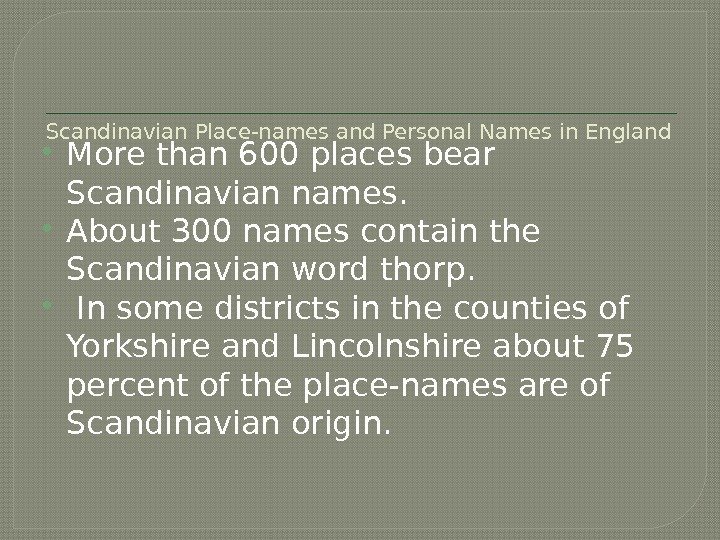
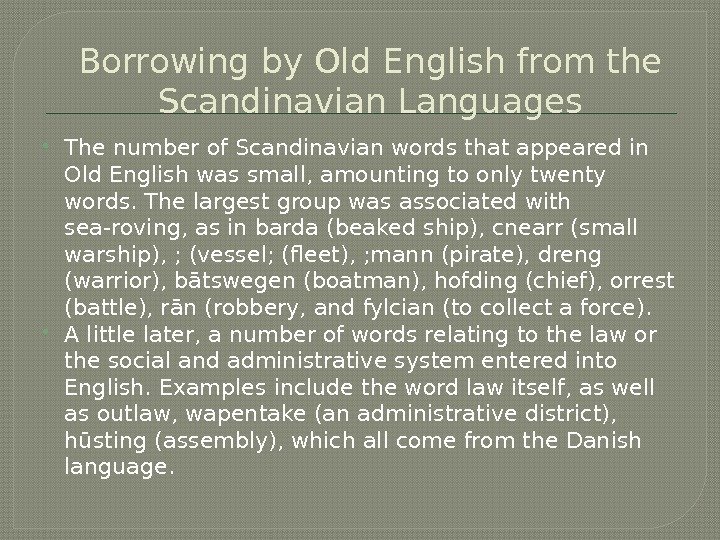
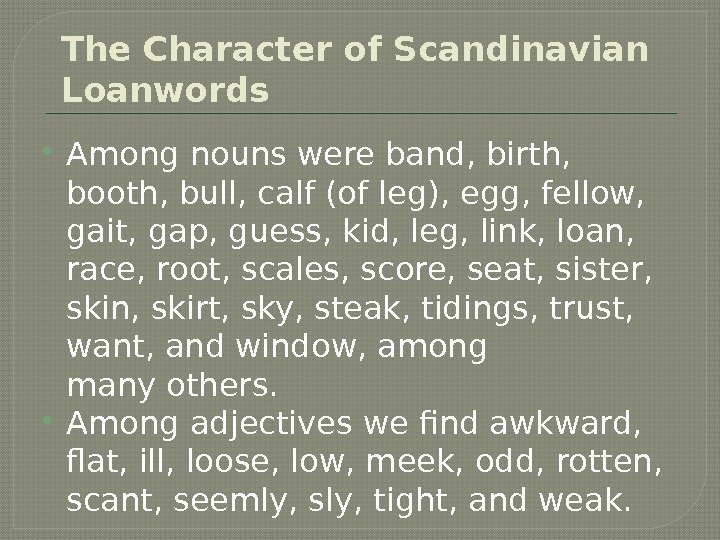
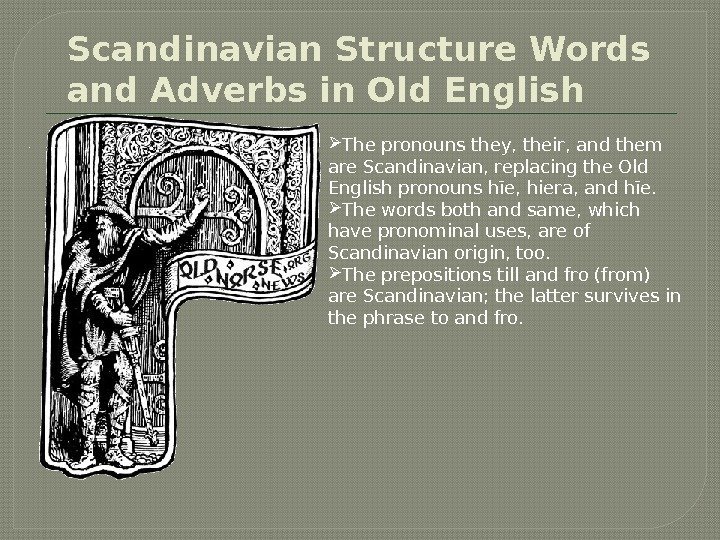
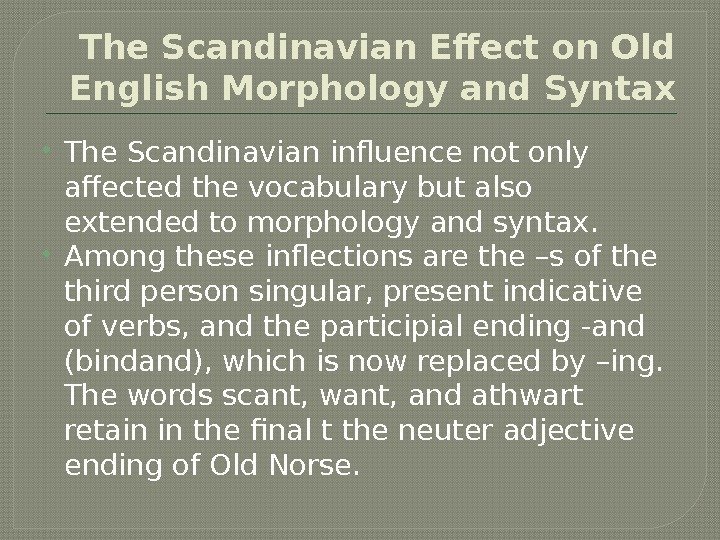

prezentaciya_skandinaviya_ot_aya.pptx
- Размер: 806.4 Кб
- Автор: Максим Дроздов
- Количество слайдов: 9
Описание презентации The Scandinavian Influence on OldEnglish ( 450 -1150) по слайдам
 The Scandinavian Influence on Old. English ( 450 -1150)
The Scandinavian Influence on Old. English ( 450 -1150)
 Introduction
Introduction
 Settlers
Settlers
 Scandinavian Place-names and Personal Names in England More than 600 places bear Scandinavian names. About 300 names contain the Scandinavian word thorp. In some districts in the counties of Yorkshire and Lincolnshire about 75 percent of the place-names are of Scandinavian origin.
Scandinavian Place-names and Personal Names in England More than 600 places bear Scandinavian names. About 300 names contain the Scandinavian word thorp. In some districts in the counties of Yorkshire and Lincolnshire about 75 percent of the place-names are of Scandinavian origin.
 Borrowing by Old English from the Scandinavian Languages The number of Scandinavian words that appeared in Old English was small, amounting to only twenty words. The largest group was associated with sea-roving, as in barda (beaked ship), cnearr (small warship), ; (vessel; (fleet), ; mann (pirate), dreng (warrior), bātswegen (boatman), hofding (chief), orrest (battle), rān (robbery, and fylcian (to collect a force). A little later, a number of words relating to the law or the social and administrative system entered into English. Examples include the word law itself, as well as outlaw, wapentake (an administrative district), hūsting (assembly), which all come from the Danish language.
Borrowing by Old English from the Scandinavian Languages The number of Scandinavian words that appeared in Old English was small, amounting to only twenty words. The largest group was associated with sea-roving, as in barda (beaked ship), cnearr (small warship), ; (vessel; (fleet), ; mann (pirate), dreng (warrior), bātswegen (boatman), hofding (chief), orrest (battle), rān (robbery, and fylcian (to collect a force). A little later, a number of words relating to the law or the social and administrative system entered into English. Examples include the word law itself, as well as outlaw, wapentake (an administrative district), hūsting (assembly), which all come from the Danish language.
 The Character of Scandinavian Loanwords Among nouns were band, birth, booth, bull, calf (of leg), egg, fellow, gait, gap, guess, kid, leg, link, loan, race, root, scales, score, seat, sister, skin, skirt, sky, steak, tidings, trust, want, and window, among manyothers. Amongadjectives we find awkward, flat, ill, loose, low, meek, odd, rotten, scant, seemly, sly, tight, and weak.
The Character of Scandinavian Loanwords Among nouns were band, birth, booth, bull, calf (of leg), egg, fellow, gait, gap, guess, kid, leg, link, loan, race, root, scales, score, seat, sister, skin, skirt, sky, steak, tidings, trust, want, and window, among manyothers. Amongadjectives we find awkward, flat, ill, loose, low, meek, odd, rotten, scant, seemly, sly, tight, and weak.
 Scandinavian Structure Words and Adverbs in Old English The pronouns they, their, and them are Scandinavian, replacing the Old English pronouns hīe, hiera, and hīe. The words both and same, which have pronominal uses, are of Scandinavian origin, too. The prepositions till and fro (from) are Scandinavian; the latter survives in the phrase to and fro.
Scandinavian Structure Words and Adverbs in Old English The pronouns they, their, and them are Scandinavian, replacing the Old English pronouns hīe, hiera, and hīe. The words both and same, which have pronominal uses, are of Scandinavian origin, too. The prepositions till and fro (from) are Scandinavian; the latter survives in the phrase to and fro.
 The Scandinavian Effect on Old English Morphology and Syntax The Scandinavian influence not only affected the vocabulary but also extended to morphology and syntax. Among these inflections are the –s of the third person singular, present indicative of verbs, and the participial ending -and (bindand), which is now replaced by –ing. The words scant, want, and athwart retain in the final t the neuter adjective ending of Old Norse.
The Scandinavian Effect on Old English Morphology and Syntax The Scandinavian influence not only affected the vocabulary but also extended to morphology and syntax. Among these inflections are the –s of the third person singular, present indicative of verbs, and the participial ending -and (bindand), which is now replaced by –ing. The words scant, want, and athwart retain in the final t the neuter adjective ending of Old Norse.
 Conclusion
Conclusion
